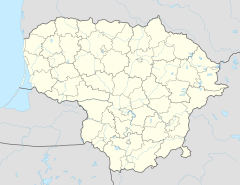Kailis forced labor camp
| Kailis forced labor camp | |
|---|---|

Former building of the camp in 2001
|
|
| Location | Ševčenkos street 16, Vilnius, Lithuania 54°40′35″N 25°15′59″E / 54.67639°N 25.26639°ECoordinates: 54°40′35″N 25°15′59″E / 54.67639°N 25.26639°E |
| Date | 5 October 1941 to 3 July 1944 |
| Incident type | Forced labor, imprisonment, mass shootings |
| Organizations | Nazi SS |
| Ghetto | Vilna Ghetto |
| Victims | About 1,000 Jews |
Kailis forced labor camp (kailis is Lithuanian for fur) was a Nazi labor camp for Jews in Vilnius (pre-war Second Polish Republic, post-war Lithuanian SSR) during World War II. It was based on a pre-war fur and leather factory and mostly produced winter clothing for the German military. At its peak, after the liquidation of the Vilna Ghetto in September 1943, the camp housed about 1,500 Jews. The camp was liquidated and its workers executed at Ponary on 3 July 1944, just ten days before Red Army captured the city.
There were several fur and leather workshops and factories in Vilnius, most of them owned by Jews. After the Soviet occupation in June 1940, private enterprises were nationalized. The three fur factories Furs, Nutria, and Ursus were consolidated and merged into one fur factory. One factory was located behind the Vilnius Town Hall. Almost immediately after the German invasion of Russia in June 1941, the factory was given orders to produce winter clothing for the Wehrmacht. Its director took measures to protect factory workers who were mostly Jewish from the atrocities committed in the Vilna Ghetto and Ponary massacre. For example, on 9 September, the director successfully petitioned the German administration to dedicate four houses within the ghetto to workers of Kailis.
On 5 October 1941, the factory was moved to the larger premises of the evacuated radio receiver factory Elektrit. The move was arranged by Oscar Glik, an Austrian Jew who managed to obtain Volksdeutsche papers and later, in effect, became director of the factory. At the time, the factory had 448 workers. Together with family members (a total of about 800–1,000 people), they lived in two large buildings at the factory site. It was a relatively safe place; the workers were one of the first to receive work permits (known as yellow Schein) that protected them from Aktions – round ups for executions at Ponary. Ghetto inhabitants considered Kailis workers as "privileged" and resented them.
...
Wikipedia

